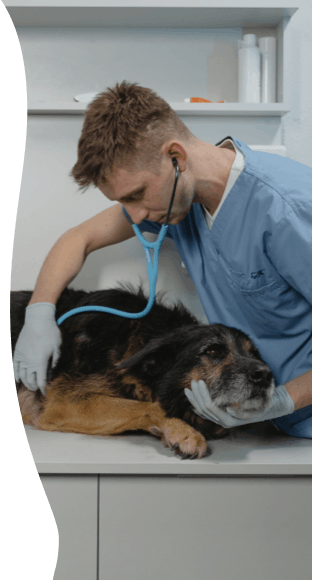Can I Give My Cat Baby Aspirin With Plavix for Hcm
What is Anticoagulant Therapy?
The aim of anticoagulant therapy is to reduce the risk of blood clots forming inside the circulatory organization that could lodge in an inappropriate place and cut off the claret supply to that area. This is analogous to what happens in a stroke, and in the cat the main site for the jell to social club is in the aorta (the primary artery leaving the centre) where information technology splits into ii to supply both back legs.
This is known as an aortic thromboembolism, which is an extremely painful condition and ultimately life-threatening. Certain cats are most at risk of throwing such a blood clot, which includes those with a middle condition known equally hypertrophic cardiomyopathy or those with hypercoagulable blood as a issue of other atmospheric condition.
Vet bills can sneak upward on you.
Program alee. Become the pawfect insurance plan for your pup.
Compare plans

Anticoagulant Therapy Procedure in Cats
In astute illness when a blood clot is causing organ failure or poor apportionment to the limbs, treatment can be given by injection. This may exist as a loading dose intravenous injection followed past a constant rate infusion (lower doses given continuously for several hours). Alternatively, therapy may be given by deep subcutaneous injection, which prolongs the release of the anticoagulation and extends the benefit. Anticoagulants tin can as well be given by deep intramuscular injection but their is a take chances of large hematomas (blood blisters) forming post-therapy.
Anticoagulant therapy has a role in the prevention of blood clot formation in patients that are at loftier run a risk. In this case, the treatment is ofttimes a low dose taken past rima oris every three to iv days. The near commonly prescribed anticoagulant is aspirin, for cats diagnosed with hypertrophic cardiomyopathy. An ultra-low dose is given, because of the feline's inability to break upwardly aspirin and it persisting for a long time in the system. Typically 81 mg per cat is given every 3 days. The apply of soluble aspirin helps to reduce the risk of gastric ulceration, every bit does giving the medication with food. Treatment should be stopped if the cat vomits or has diarrhea.
Top
Efficacy of Anticoagulant Therapy in Cats
The use of anticoagulants in cats is far less advanced than in humans. For several reasons, therapy is oft disappointing, and cats that have already thrown a claret jell stop up being euthanized because of severe pain and the poor prognosis.
In part, this is due to the unlike ways in which anticoagulants are metabolised by cats. This ways substances such as heparin, which are a mainstay in human medicine, are more rapidly broken down making therapeutic levels more difficult to obtain.
The use of anticoagulants also has to be balanced against an increased gamble of bleeding. This means therapy is not always appropriate given the lifestyle of some cats and a propensity to fight or chase. Indeed, for cases of DIC, anticoagulants such equally heparin should not be given unless the patient likewise receives a claret transfusion.
Top
Anticoagulant Therapy Recovery in Cats
The idea of anticoagulant therapy is to prevent a catastrophic event such as a blood jell forming. Thus, successful treatment maintains a state of normalcy, such that the cat doesn't deteriorate. In this regard, at that place is no catamenia of recovery from treatment.
Top
Cost of Anticoagulant Therapy in Cats
The most commonly used anticoagulant in the true cat, aspirin, costs simply a few cents per dose. However, the workup to diagnose the hypertrophic cardiomyopathy is likely to involve a cardiac ultrasound costing anywhere from $180 to $500 depending on the skill and feel of the operator.
Top
Cat Anticoagulant Therapy Considerations
Few controlled studies using heparin in animals and due to the complexity of balancing the risks and benefits, information technology is not unremarkably used exterior of specialist referral hospitals. Other drugs widely used in people, such as warfarin, are used sparingly and rarely in cats, because unpredictability of response can lead to agile bleeding.
The most ordinarily used anticoagulant in cats is aspirin, used in ultra-depression doses. The benefit in loftier risk cases is dubious, but for those animals that don't suffer side furnishings (such as gastric ulceration) and then it'due south worth a try. Aspirin is inexpensive and the small doses involved mean the minimum of inconvenience to patient and owner.
Top
Anticoagulant Therapy Prevention in Cats
Hypertrophic cardiomyopathy (HCM) is the main indication for prescribing anticoagulant therapy in cats. Feeding a high quality meat based diet, rich in taurine, helps provide vital nutrition to promote a good for you centre muscle.
There are well-recognized links between hyperthyroidism (overactive thyroid glands) and HCM. Since there is no proven crusade for hyperthyroidism, an owner should be vigilant for clues and seek early treatment to control and correct the condition.
Symptoms of hyperthyroidism include:
- Ravenous appetite and notwithstanding weight loss
- Drinking excessively and excessive wet patches in the litter tray
- Dull, stary coat
- Poor body condition
- Hyperactivity
There are many different ways of treating hyperthyroidism so early identification and control could prevent HCM and the demand for anticoagulants.
Top
*Wag! may collect a share of sales or other compensation from the links on this page. Items are sold by the retailer, not Wag!.
Can I Give My Cat Baby Aspirin With Plavix for Hcm
Source: https://wagwalking.com/cat/treatment/anticoagulant-therapy
0 Response to "Can I Give My Cat Baby Aspirin With Plavix for Hcm"
Post a Comment